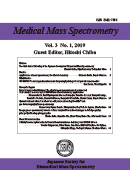Volume 3, Issue 1
Displaying 1-7 of 7 articles from this issue
- |<
- <
- 1
- >
- >|
Preface
-
2019 Volume 3 Issue 1 Pages 1
Published: June 25, 2019
Released on J-STAGE: September 08, 2020
Download PDF (139K)
Review
-
2019 Volume 3 Issue 1 Pages 2-10
Published: June 25, 2019
Released on J-STAGE: September 08, 2020
Download PDF (1449K)
Mini Review
-
2019 Volume 3 Issue 1 Pages 11-18
Published: June 25, 2019
Released on J-STAGE: September 08, 2020
Download PDF (651K)
Research Papers
-
2019 Volume 3 Issue 1 Pages 19-29
Published: June 25, 2019
Released on J-STAGE: September 08, 2020
Download PDF (686K) -
2019 Volume 3 Issue 1 Pages 30-34
Published: June 25, 2019
Released on J-STAGE: September 08, 2020
Download PDF (380K) -
2019 Volume 3 Issue 1 Pages 35-42
Published: June 25, 2019
Released on J-STAGE: September 08, 2020
Download PDF (6071K)
Short Communication
-
2019 Volume 3 Issue 1 Pages 43-47
Published: June 25, 2019
Released on J-STAGE: September 08, 2020
Download PDF (439K)
- |<
- <
- 1
- >
- >|
